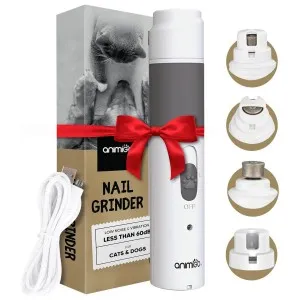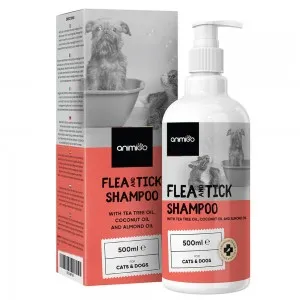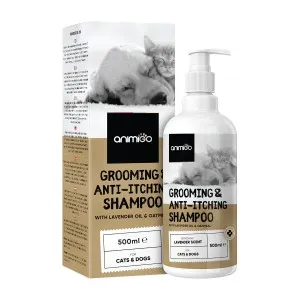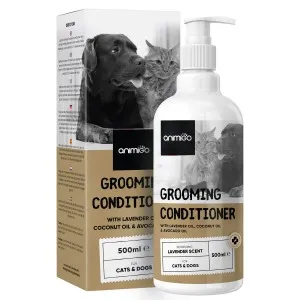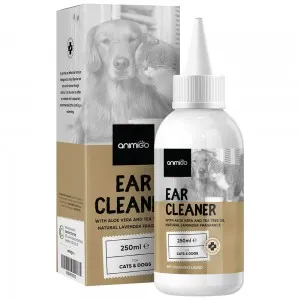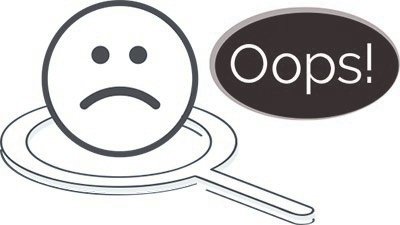100% Customer Satisfaction
Full 90-day money back guarantee
Free UK Delivery
Enjoy free shipping on orders above £30
Natural & Delicious Pet Supplements
Get nutritious, pet-safe & cruelty-free solutions

Grooming
Filters
Dogs
Type
Price
Rating
Pet grooming involves cleaning and looking after your dog, focusing on their outsides and physical appearance. Some people just focus on brushing their coat, but it can also involve caring for their skin, nails, eyes and teeth. There are many different techniques for grooming your dog, so it’s important that you choose methods that fit your dog’s needs and preferences as well as your grooming abilities.
Why groom your dog?
Some think that pet grooming is superficial and all about making your dog look pretty, but it is actually so much more than that. Grooming can keep your pet’s fur clean, healthy and manageable and is a great chance to check for skin issues, cuts, scratches and fleas or other parasites. It also acts as a preventative measure to stop hair from getting matted, and can help deal with dry skin and reduce any irritation. Keeping their teeth, eyes and nails are also important to their wellbeing, and are often grooming areas that are overlooked. In addition to the physical health benefits of dog grooming, there are also emotional ones. Looking after your pet helps to build that essential bond and shows them that you care.
How often should I groom my dog?
There is no set time or duration in which you need to groom your dog - it is all down to them. Short-haired breeds generally require brushing around once a month, medium-haired breeds once a week and long-haired breeds every day. Bathing your dog should, regardless of hair length, generally be once a month (unless they like to run through muddy puddles on a daily basis!). For other types of grooming that is not fur-related, nail clipping should generally be around every 1-2 months, teeth brushing every week and eye cleaning every few days. This is no set science or routine though, so it is best to determine your dog's own needs first and adjusting from there.
Puppy grooming
When it comes to grooming a puppy, the principles are the same as any aged dog. The main differences will be that you need to learn their behaviour and needs to create a grooming routine that works for them, plus they can be more likely to get messy and dirty. You may also find it more difficult grooming a puppy as they may not understand what you are doing. This is why you need to teach them that grooming is a pleasant experience. Make sure to create a calm environment and give them lots of praise to reinforce good behaviour during grooming. This will make it easier to groom them now as well as in the future.
Dog grooming at home
Grooming your dog at home is a great way to save some money. Dog cleaning may seem like a daunting task at first, but as you and your dog build confidence, it will become as simple as ever and maybe even something you can both enjoy! Here are some of the different types of dog grooming you can do from the comfort of your own home:
Brushing your dog's fur
Make sure that they are happy and calm and that you have chosen the right brush and grooming tools for their specific fur. Start at the head and brush down their body, making sure to cover all of their fur. If you come across a few knots, you can try gently brushing them out or teasing them with your fingers. If there is frequent knotting or matting, try a dog detangler spray as these can take some of the hassle out of brushing.
Giving your dog a bath
Most dogs aren’t fond of bath time so having a dog bath can often be a challenge. Before you start make sure to either put down a slip-proof mat or bathe them somewhere they won’t slide around. Also only use lukewarm water; like Goldilocks, you don’t want it to be too hot or too cold. When it comes to dog bath products, you need to ensure that your dog wash products are natural and specifically made for pets - never use a human shampoo on your pooch as their pH is different to ours. Shampooing and conditioning your furry friend is a key step to grooming as it can help with removing dirt and odours, getting rid of pests, calming the skin and making the coat look healthy and shiny.
Clipping your dog's nails
Dogs nails grow just like ours do, and if they get too long they can curl into the paws or pads, resulting in pain and a number of health issues. But how to tell if your dog’s nails need clipping? If you can hear them tapping on the ground as they walk, they need a trim. Take a small pair of scissors and carefully clip at the ends. Make sure you only cut off the clear part, not the pink as this is where the blood vessels are located. Think of your own nails and what you would cut off for reference. This type of dog grooming at home is easy to do but often overlooked, so make sure not to forget it and make it a part of your routine!
Brushing your dog's teeth
Dog oral hygiene is a big part of keeping them happy and healthy and a great way to care for their teeth is to brush them regularly. You can either simply brush with a toothbrush, or use a specific dog toothpaste. These are specifically tailored to be safe for dogs, as they are more likely to swallow it than us. You can use the toothpaste on a brush or put some on your finger and rub around their teeth. Cleaning your dog's teeth not only keeps them healthy but can also freshen their breath and make them more pleasant to be around.
Cleaning your dog's eyes and ears
Dirt, debris and oil can build up around your dog's eyes and in their eyes, so it’s important to make sure they’re kept clean. Cleaning their eyes usually just requires simply wiping away any dirt with a tissue or damp cloth. If your pet has tear staining, it is usually best to use a natural tear stain remover as these won’t irritate their skin. Cleaning your dog's ears is similar; try wiping away any easy to reach dirt or ear wax, but never stick anything straight into their ears. To get rid of deeper dirt, try using a natural ear cleaner solution as these work to break down stubborn wax and allows you to simply wipe it away.
Professional dog grooming
If you don’t want to groom your dog from home, or find it too time-consuming, you can take them to a professional. Depending on the place, they will look after all sizes of dogs and even do small dog grooming which can be the trickiest and most precise. Most groomers will perform all types of dog care, from washing to clipping their nails, so visit your local groomers for more information and prices. If there is not one near you, try finding a mobile dog grooming salon and see when they will be in your area.
However you choose to groom your dog, make sure to do it regularly and to tailor it according to their needs. Each dog is different, so don’t follow what your friend is doing just because it works for them. Also make sure to take the time to find the right grooming products for you; you may not need all of them but there are some staples such as shampoo and conditioner that are usually needed for all dog, whilst specific breeds will always require certain products such as tear stain removers or fur detanglers.
